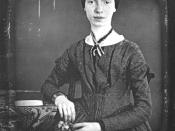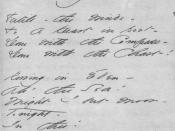Emily Dickinson's poem, "I heard a Fly buzz", is a seemingly simple poem on the surface. The poem is written in ballad form, and contains four quatrains. Each stanza alternates between iambic tetrameter and iambic trimeter, and provides the basic rhythm of the poem. This regular iambic rhythm of an unstressed syllable followed by a stressed, give the poem a singsong, or chanted feel. In a traditional ballad stanza the second and fourth lines usually contain an end rhyme. However, Dickinson diverts away from this form and uses slant rhymes like "died" and "air" (L.1, 3), as well as internal rhymes like "Eyes" and "dry" (L.5), to draw connections, and maintain a fluid motion throughout the poem. Dickinson also uses alliteration, consonance, assonance, and repetition to ease the poem along and stress important themes. The consistent meter throughout the poem is disrupted by Dickinson's use of hyphens, which appear not only at the end of lines, but also in the middle breaking up the monotony and forcing the reader to pause unnaturally.
"I heard a Fly buzz" examines the idea of death as seen by a person contemplating his or her own mortality. Throughout the poem, Dickinson delves deeply into the mind of one who is afflicted with the idea of her own death, the anticipation thereof, and the loss of expectations associated with dying. Death is not as it seems, and the poem chronicles a person imagining his or her own death, and the harsh realities of losing control and human consciousness.
The anticipation of death is prevalent throughout the first quatrain. The poem opens with "I heard a Fly buzz--when I died--"(L.1), and immediately we get an unsettling feeling. The idea of a fly buzzing brings forth images of decay or dirtiness, which is...


